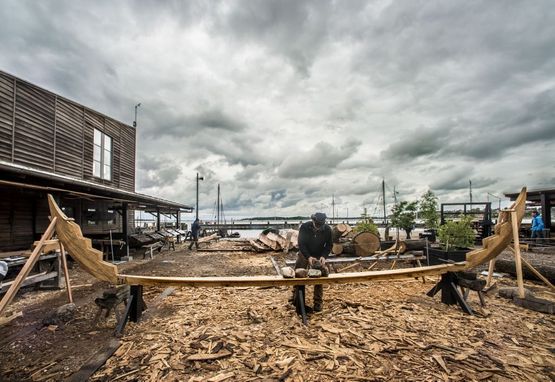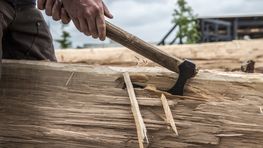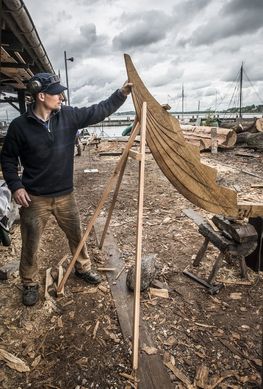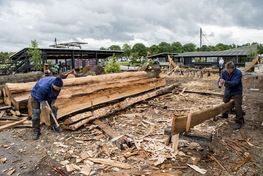We’ve now moved into August and are approaching the start of the third month of the Gislinge Boat Open Source Project. Looking back, it feels like a hell of a lot longer than three months since we first began! It also seems like a good point to sit back and take stock of the project, and what it has taught us, so far.
New approaches
From the start, this project was something new for the Museum. Combining traditional boatbuilding with open source approaches and social media is something that, to the best of our knowledge, hasn’t been tried before. So for us in the project group, I think it’s fair to say there was a sensation of stepping out into the unknown. Open source boatbuilding. How would that work? Would there even be an audience who wanted to engage with it or was the interest in maritime craftwork actually only limited to a tiny group of (probably, not very online) people? Instagram. Instawhat? There wasn’t a single one of us in the project group who had even tried using it before. Hashtags, uploads, downloads, dropboxes, smartphones, blogs, Facebook and everything else in between. A brave new world, for a bunch of people who – excepting Rikke, our web expert – are not exactly technically-minded. But, during the spring, we started taking tentative steps forward, trying to figure it all out, and on the 14th of May, we stepped out into that great unknown.
Online community
And something very lovely happened. It turned out Instagram wasn’t just for selfies and food-photos. It turned out there was a world of incredibly skilled and interested craftsmen and women out there in the Instasphere, who started to engage with our project and helped spread the word about the construction of the Gislinge Boat. Facebook also became our friend. The updates we posted about the project became more and more popular and we could see that we were beginning to get a regular ‘audience’ who engaged with each of the posts we made.
And that audience grew. Since the start of the project in May, we’ve gained ca. 2,000 new followers on Facebook. You might think, ‘So what? Is this just a popularity contest now?’ and the answer would be that no, it’s not. The whole aim of the project was to promote and communicate traditional maritime craftwork and both Facebook and Instagram are platforms that allow us to do that with an ease and immediacy that would have been unthinkable just 10 years ago. We’re not going to convince everyone who likes or shares a photo to pick up an axe and become a boatbuilder, but we can give them an insight into the materials, methods and skills involved in building boats, both now and in the past, and perhaps spark an interest in learning more about it.
As for us, we’ve only dipped out toes into the potential that social media has in terms of how the Museum can communicate. We still have a world of things to learn, but we’re having fun in the process.
Another new departure for the project was hiring Silas, a specialised guide with expertise in forestry, to be affiliated with the project. Silas has been able to bring his own knowledge and skills to bear on a series of boatbuilding-related workshops that he runs at the boatyard, where kids and adults alike can try to cleave logs, shape planks and fell trees, just like the boatbuilders do. The workshop is sited just next to the Gislinge Boat, which has given a whole new dynamic in terms of the way the public observe and interact with the boatbuilders as they work.
Interest in boatbuilding
Media interest in the project has also begun to grow. One aspect that has repeatedly struck all of us, is that you could almost say that most people are essentially uninterested in the story of the original Gislinge Boat. In contrast to the construction of Sea Stallion or Ottar, where people were gripped by the narrative of these large war and trading ships, with this project it seems to be the craftwork involved in boatbuilding that has captured people’s attention, and not the story of the Gislinge Boat itself. Fair enough, a small 12th century working boat can’t exactly compete with a 30m long warship in terms of wow-factor, but I can’t help but wonder if it isn’t the way in which social media has allowed us to share the boatbuilders craft – through film, photos and text – as and when it happens that makes the project interesting for people. Videos of cleaving, shaping the forestem and felling the oak in the forest have been viewed, shared, liked and commented on thousands of times. One film on the cleaving process has been seen over 1,000,000 times on facebook alone.
I know that for me as an archaeologist, I’m constantly blown away by observing the skill of the boatbuilders. Perhaps it’s the same for the rest of you. Feel free to comment about this below, by the way – I am genuinely interested in knowing what it is that makes people so interested in this project…
Open source boatbuilding
And what about the heart of the open source project? The concept Søren developed whereby the working drawings would be made available for free download? Again, in the beginning, the ambitions were pretty modest. We thought that if there was a handful of people who downloaded them and built their own Gislinge Boat, then we’d count it as a success. To date, over 150 people from all corners of the world have downloaded the drawings and are intending to build the boat, either as a model or in full scale. We’ve literally had contact from people from Argentina to Australia and from Canada to Estonia, all of whom have downloaded the drawings. Unbelievable.
When we stand chatting about that at the boatyard, next to the hull of the Gislinge Boat, it seems so incredible to us that we can’t quite get our heads around it. But I can promise you, that it makes us smile.
» <link https: www.facebook.com external-link-new-window external link in new>Follow the project on Facebook...
» <link https: instagram.com vikingshipmuseum external-link-new-window external link in new>Follow the project on Instagram...



